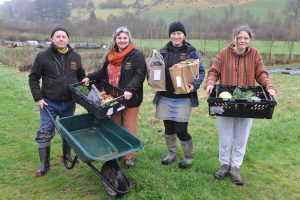WELSH farmers and gamekeepers have shown their long-term commitment to conservation alongside productive land-use by completing this year’s GWCT Big Farmland Bird Count in record numbers.
The Game & Wildlife Conservation Trust’s Director for Wales, Sue Evans, said: “We could not be more delighted with the response to this year’s GWCT Big Farmland Bird Count. Despite adverse weather during the count (5-21 February) participation in Wales has gone up a spectacular 91% in the last two years.
“This year 115 farmers in Wales took part, a 37% increase on last year. Participants recorded 107 species across more than 34,000 acres.
“All of this helps us to build a detailed picture of the state of farmland birds in Wales, allowing us to better understand what is really going on with Welsh wildlife. We would like to thank everyone who took part for demonstrating that land managers can lead the way in protecting and enhancing our countryside alongside effective food production.”
The 2021 GWCT Big Farmland Bird Count has shown some encouraging results in Wales. A total of 22 species from the Red List for Birds of Conservation Concern were recorded in this year’s count, with starling, fieldfare, yellowhammer and song thrush appearing in the 25 most frequently seen species list. Starling, fieldfare, lapwing, linnet and yellowhammer were the five most abundant red listed species recorded with over 5,400 individuals spotted, which equates to more than 21% of all birds counted.
The five most abundant birds seen across Wales were woodpigeon, starling, chaffinch, fieldfare and lapwing. A total of over 9,200 were counted, making up over 36% of the total number of birds recorded.
The GWCT Big Farmland Bird Count asks land managers to spend 30 minutes recording the bird species they see on their land as part of an annual UK-wide survey which helps to identify any species which are struggling. The count is a simple way for farmers and gamekeepers to assess the natural capital on farm, an increasing requirement under the government’s Sustainable Farming Scheme and to chart the effects of any conservation they carry out. Completing it year after year can help to establish the bio-diversity gains from long-term conservation efforts. The scheme was launched in 2014 to highlight the positive work done by farmers and gamekeepers in helping to reverse the decline in farmland birds.
The GWCT Big Farmland Bird Count is supported by the Farmers Union of Wales (FUW). FUW President Glyn Roberts said:
“The aim of the Big Farmland Bird Count is to raise awareness of the great conservation work being done on farms across Wales and to highlight what can be done to help farmland birds survive this difficult time of year so that the breeding populations are increased.
“We are pleased that so many farmers took part this year. It all helps us build a picture of how farming, alongside conservation, can achieve great things for the environment. It is important that the next Welsh Government and conservation bodies work with farmers. 80% of Wales is farmed land, and whilst some organisations can highlight what’s happening on small nature reserves, you have to work with farmers if you want these things to be successful across the country.”
Farmers from 12 Welsh counties took part in the 2021 count. Powys had the most returns, with 30 farmers completing the survey. It was followed by Ceredigion with 23, Monmouthshire with 17 and Pembrokeshire with 14.
The average farm size of those taking part was 299 acres. 58% of participants are in some form of agri-environment scheme, demonstrating their long-term commitment to environmental management.
47% of participants were providing some form of extra seed feed for birds, either through growing wild bird seed mixes, or by providing additional winter feed.
The GWCT Big Farmland Bird Count is a UK-wide initiative. The 2021 count total UK results saw a 65% increase in the number of counts submitted compared to 2020, which was also a record year. The land area covered by the count has more than doubled to over a million hectares and 81% more birds have been counted this year by more than 700 additional volunteers.
Participation rates increased in England, Wales and Scotland. Word of the scheme has also spread beyond the UK’s shores, with surveys coming in from a number of farmers in Austria.
The GWCT would like to thank the NFU for sponsoring the GWCT Big Farmland Bird Count, which it delivered in partnership with the FUW (Farmers Union of Wales), UFU (Ulster Farmers’ Union), CLA, Kings, CFE, the FWAG Association, National Sheep Association, Camgrain and LEAF.


















Add Comment